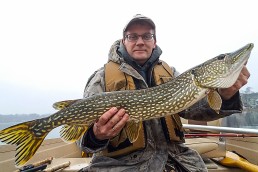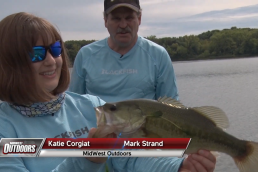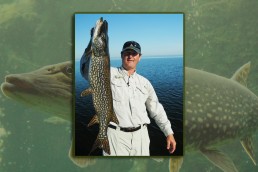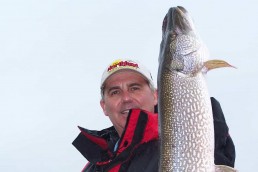Targeting Harbor Pike
SHARE THIS POST
As a young man many years ago, I had the honor to work with the legendary charter captain Bob Hesiak. Bob was one of the original charter captains in the Milwaukee area. These early captains were the first ones on the water when this trout and salmon fishery evolved. They had to figure this all out!
The good old days
Bob was about 20 years older than me at the time, and was a lifelong resident of the Milwaukee, Cudahy, south Milwaukee area. His stories of fishing Lake Michigan as a kid always intrigued me. This was pre-salmonid days when perch were plentiful, and a variety of other game species were the target of nearshore anglers.
The stories that most notably caught my attention were the stories of big pike cruising the nearshore weed beds in the area. Bob spoke of 3-footers coming on a regular basis, and an occasional 40-inch fish being caught by Bob and his teenage fishing buddies.
As a longtime muskie and pike enthusiast, I thought about how cool it would be to have a secondary species like big pike to pursue when the waters weren’t right for trout and salmon. I was dreaming about weed beds that would hold pike. These factors just didn’t exist back 30 years ago when Mr. Hesiak waxed poetic about the good old days of native Lake Michigan pike. This wasn’t Sturgeon Bay. They have had this fishery. I’m talking about the harbor cities, from Algoma south to Kenosha.
Today
Fast forward to today. In the past 20 years, the fishery has changed, and changed for the good. I won’t get into all the factors, but the waters cleared, the weeds slowly came back, and those weeds have provided the habitat for the comeback of the Lake Michigan northern pike.
We would catch an occasional pike back in the late ‘70s and ‘80s. But the incidence was as rare as a 7-foot man. In the past five years, things have changed. I can honestly say that there is a legitimate population of pike in every port that is worth targeting. And I’m writing about it today because these coming months of October and November are the best months to try to target a big pike in one of our Lake Michigan harbors.
Pike start to get very active in late August, when it starts to be noticeable that the days are getting shorter. I’ve followed water temps, and although the temps start to fall by late August, water temps don’t seem to be the trigger. It seems to be photo-period that triggers the sudden activity. This activity holds together through the fall till early December, when the water temps sneak below 40 degrees.
Location, location, location
Whether it’s pike or real estate, it’s all about location. You can haphazardly cast harbors and eventually catch a pike, but we are talking about targeting pike in this piece. We are eliminating water and focusing on specific spots. These pike crave cover or structure. Most harbors are somewhat void of structure compared to an inland lake, so anything you can find will have a shot at holding pike. I have spoken with DNR shocking crews and when they see anything as small as a 4-foot section of branch in the water, it may very well be holding a pike.
Weeds
Harbor weeds are a magnet for big pike. Once nearly gone, weed beds are on the return these days. Some may be visible, but most you must search out. These may not be the big thick weeds that you are accustomed to seeing in inland lakes. They may hug the bottom only a foot tall in 15 feet of water. While fishing during the season, I search the bottom for them to note for pike season. Blade baits or deep-diving crankbaits, worked along the bottom, can find these weeds. The more isolated the better. Make note of any bottom structure you find over the course of the season, as it will attract a pike when the fall comes around. Big weed beds are a little tougher to fish, so look for edges to check, as this species is an ambush feeder.
Are you enjoying this post?
You can be among the first to get the latest info on where to go, what to use and how to use it!
Steel seawalls
After weeds, my second favorite structure is a steel seawall. Pike love to lie on the bottom at the base of a seawall, waiting for something cruise by. These seawalls are highways for all kinds of fish, and these pike will snuggle down deep at the base to let the food come to them. The best way to fish these seawalls is to make long casts parallel to the wall and work the bait just off the bottom. The base of the seawall can generally be full of mussels and debris, so you will want to keep your bait a foot or so off the bottom. Shore trolling and walking a bait along a stretch of wall, can be deadly.
Rock ‘n rubble
Rock and rubble seawalls are another pike magnet. These rocks offer many ambush points, and attract a lot of baitfish for the pike. They are a little more difficult to fish than a seawall, so a little more touch is needed to stay away from snagging expensive lures. Unlike a seawall where the pike are at the base, they can be all over rubble walls. A hot spot is where a rubble wall ends or terminates into a seawall.
Other structures
Some other structure items to note could be wooden dock pilings or concrete piers for bridges, or building foundations. Remember, these harbor pike don’t have a lot of cover, so they will adapt to anything that offers an ambush point.
Lures
Let’s get to lures. I’ll start out by saying that just about anything can work once. But since I have been targeting them specifically, I’ll give you my three that I go to and know for sure that they work.
Let’s start shallow, three to 10 feet. Shallow weed beds. The number one bait for pike in this application is the minnow bait in the 4- to 5-inch range, such as Storm ThunderSticks, Rapala Shadow Raps, #14 Husky Jerks, Bandit Walleye Shallow, and Yo-Zuri Minnows. Pike love flash, so pick a bait with the flash insert or a metallic finish. Minnow baits should be worked erratically, or in sweeps and pauses.
Going a little deeper, like 8 to 12 feet, I really like a heavy spinner. A #4 Mepps Aglia or Aglia long are the perfect size for harbor pike. I like brass or copper blades with a white or yellow tail hair. Cast them out and let them sink to the bottom, then start the retrieve and hold a speed that is just enough to keep the blade spinning smoothly without skipping. Speed up a little as it gets closer to try to trigger followers.
For deeper water, hands down, my choice is a blade bait. Sonars, Zips, Big Dudes in brass or firetiger are pike killers! They love the flash, they love the vibration and they love the incidental bottom contact. If you are ticking those deep weeds and there is a pike around, they will smash it!
One last note: pike have teeth and it’s irresponsible to fish without a leader in the fall if you are targeting pike. Use the lightest wire leader you can find. The best option is a handmade leader, using light single strand piano wire material. I use a #2 Duo-Lock snap on one end and a black #10 swivel on the other end. Use a “Haywire Twist” for connections. They don’t have to be long leaders. A 4- to 6-inch length will prevent any bite-offs. Coffee-colored .010, .011, or .012 single strand wire is nearly invisible, and I have caught many large browns when using the leader, so I feel confident that I am not spooking other fish using a thin wire.
Pike populations are real right now. Harbors are holding legitimate amounts of pike over 30 inches, and it’s not unusual to tangle with 3-footers on a regular basis. If the salmon run slows up and you want to tangle with a “harbor gator,” check out the structure elements I mentioned and hang on.
MWO
SHARE THIS POST
Did you enjoy this post?
You can be among the first to get the latest info on where to go, what to use and how to use it!
Marc Wisniewski
Marc Wisniewski is an avid Wisconsin angler specializing in Lake Michigan shore and inshore fishing. He also chases bass, pike, and muskies anywhere he can. He has built custom rods for 35 years and makes lures from wood, lead and soft plastics. Wisniewski has been writing fishing articles for more than 30 years.



